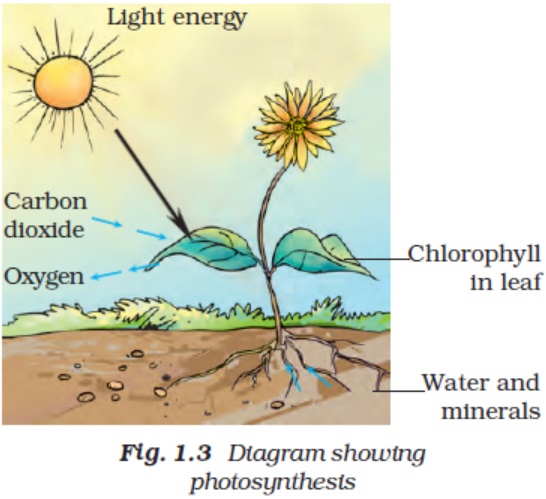GetStudySolution
Getstudysolution is an online educational platform that allows students to access quality educational services and study materials at no cost.
NCERT Solutions for class 7 Science chapter 1 – Nutrition in Plants
Back Exercise
1. Why do organisms take food?
Solution:
All organisms require energy for their life processes. Plants prepare their food and acquire nutrients from abiotic components like soil, air, water and sunlight. On the other hand, animals need to get food from either plants or other animals to obtain nutrients; hence animals need to take food to acquire nutrients and energy.
2. Distinguish between a parasite and a saprophyte.
Solution:
| Saprophytes | Parasites |
| Acquire nutrients from dead and decaying matter | Parasites live on or in a host and get its food at the expense of its host |
| Example: Fungi | Example: roundworm |
3. How would you test the presence of starch in leaves?
Solution:
Take two potted plants of the same kind. Keep one in the dark for 72 hours and the other in sunlight. Perform the iodine test with the leaves of both the plants as given below. Now leave the pot which was earlier kept in the dark, undisturbed for 3 – 4 days and perform the iodine test again on its leaves.
Iodine test:
Put iodine solution on the leaf
Observation:
Blue-black colour will be observed on the leaves of the plant kept in sunlight, which indicates the presence of starch.
Blue-black colour will not be observed on the leaves of plant kept in the darkroom. This indicates the absence of starch.
4. Give a brief description of the process of synthesis of food in green plants
Solution:
Green plants use a process called as photosynthesis to prepare their food. The process is as follows
- Water is taken from the roots of the plant, and it is transported to leaves of the plant.
- Carbon dioxide from air enter the leaves through pores called stomata. This diffuses the cell containing chlorophyll.
- Water molecule is broken down into Hydrogen and Oxygen with the help of sunlight.
- Hydrogen combines with Oxygen and Hydrogen to form carbohydrates.
- Photosynthesis is represented by the following equation.

5. Show with the help of a sketch that plants are the ultimate source of food.
Solution:

6. Fill in the blanks:
(a) Green plants are called _________________ since they synthesise their own food.
(b) The food synthesised by plants is stored as _________________.
(c) In photosynthesis solar energy is absorbed by the pigment called ___________.
(d) During photosynthesis plants take in ______________________ and release __________________ gas.
Solution:
(a) Green plants are called autotrophs since they synthesise their food.
(b) The food synthesised by plants is stored as starch.
(c) In photosynthesis, solar energy is absorbed by the pigment called chlorophyll.
(d) During photosynthesis, plants take in carbon dioxide and release oxygen gas.
7. Name the following:
i) A parasitic plant with yellow, slender and branched stem.
ii) A plant that is partially autotrophic.
iii) The pores through which leaves exchange gases.
Solution:
i) Cuscuta
ii) Pitcher plant
iii) Stomata
8. Tick the correct answer:
(a) Cuscuta is an example of:
(i) autotroph
(ii) parasite
(iii) saprotroph
(iv) host
(b) The plant which traps and feeds on insects is:
(i) Cuscuta
(ii) china rose
(iii) pitcher plant
(iv) rose
Solution:
(a) (ii) Parasite
(b) (iii) pitcher plant
9. Match the items given in Column I with those in Column II:
| Column- I | Column-II |
| Chlorophyll | Rhizobium |
| Nitrogen | Heterotrophs |
| Cuscuta | Pitcher plant |
| Animals | Leaf |
| Insects | Parasite |
Solution:
| Column- I | Column-II |
| Chlorophyll | Leaf |
| Nitrogen | Rhizobium |
| Cuscuta | Parasite |
| Animals | Heterotrophs |
| Insects | Pitcher plant |
10. Mark ‘T’ if the statement is true and ‘F’ if it is false:
(i) Carbon dioxide is released during photosynthesis. (T/F)
(ii) Plants which synthesise their food are called saprotrophs. (T/F)
(iii) The product of photosynthesis is not a protein. (T/F)
(iv) Solar energy is converted into chemical energy during photosynthesis. (T/F)
Solution:
- False
- False
- True
- True
11. Choose the correct option from the following:
Which part of the plant takes in carbon dioxide from the air for photosynthesis?
(i) Root hair (ii) Stomata (iii) Leaf veins (iv) Petals
Solution:
The answer is (ii) Stomata
12. Choose the correct option from the following:
Plants take carbon dioxide from the atmosphere mainly through their:
(i) roots (ii) stem (iii) flowers (iv) leaves
Solution:
Answer is(iv) leaves
13. Why do farmers grow many fruits and vegetable crops inside large greenhouses? What are the advantages to the farmers?
Solution:
Fruits and vegetable crops are grown in large greenhouses because it protects crops from external climatic condition and to provide suitable temperature for the growth of crops.
Advantages to farmers while growing fruits and vegetable crops inside greenhouses are
- It protects crops from diseases and adverse climatic conditions.
- It protects crops from wind and rodents